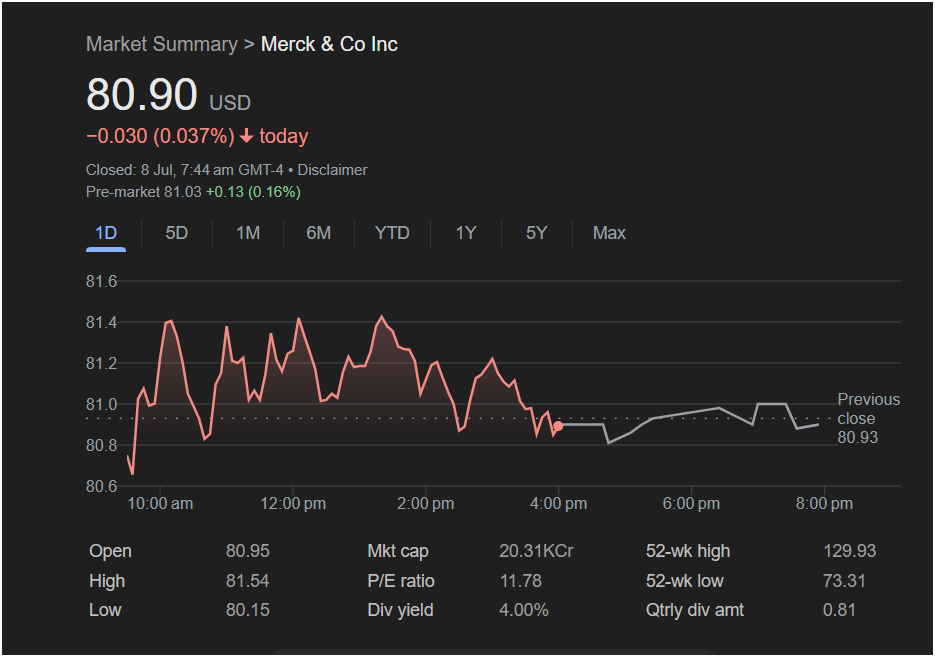The War of Attrition at $81: Merck Stock Ends Dead Flat in a Day of Vicious, Unseen Combat

KENILWORTH, NJ – July 8th – In what can only be described as a masterpiece of market indecision, shares of the pharmaceutical colossus Merck & Co Inc. (NYSE: MRK) ended Friday’s trading session in a perfect, unnerving stalemate. The stock closed at
0.030, or 0.037%. This closing print, a statistical rounding error, is a profound deception. It conceals a day of brutal, gladiatorial combat fought in the trenches of the stock market, a violent struggle between two diametrically opposed armies of investors that ultimately resolved nothing and everything.
The day’s trading chart was not a gentle meander but a jagged, violent seismograph, the fever chart of a patient in critical condition. The stock whipsawed violently throughout the session, surging to a high of
80.15 before finding desperate support. This furious, multi-dollar trading range, all to end precisely where it began, tells a story far more profound than the final number suggests. It reveals a company at a precipice, locked in a state of high-tension equilibrium between a past of immense glory and a future of deep uncertainty.
This is the story of a war being waged over Merck’s very soul. On one side stands the “Dividend Phalanx,” an army of value investors who see a blue-chip behemoth trading at a stunningly low Price-to-Earnings (P/E) ratio of 11.78 and yielding a fortress-like dividend of 4.00%. They see a generational buying opportunity. On the other side stands the “Legion of Doom,” a cohort of skeptical bears who see a company trading nearly fifty dollars below its 52-week high of $129.93, staring down the barrel of a catastrophic patent cliff that threatens to decimate its future earnings. They see a classic value trap.
The pre-market data, indicating a slight positive open at $81.03, offers no real clue as to who will win the next day’s battle. Friday was not a day of resolution. It was a day where two immense and immovable forces met on the field of battle and fought to a perfect, bloody draw. The question that hangs heavy over the market is a simple one: Is the coiled spring of Merck’s stock preparing to rocket higher in a massive validation of its value, or is it about to snap downwards in a final, painful capitulation to its fears?
Part I: The Trenches of the Intraday Chart – A Chronicle of a Battle Fought to a Standstill
To truly understand the tension of the day, one must walk through the trenches of the intraday chart, where every tick represented a minor victory or a crushing defeat for the warring factions. The session was a chaotic symphony in three movements: The Morning Volley, The Midday Melee, and The Exhausted Ceasefire.
Act I: The Morning Volley (9:30 AM – 11:00 AM ET)
The opening bell at $80.95 was immediately followed by a sharp dip, a quick feint by the bears to test the bulls’ resolve. But the bulls, the Dividend Defenders, were ready. They saw the dip below the previous close of
81.54**. This was the bulls’ main offensive charge. They were attempting to break the recent downtrend and signal that a bottom was in.
However, as the stock crested above $81.50, it ran into a wall of sellers—the Legion of Doom. These were the bears, the patent-cliff watchers, who viewed any strength as a chance to sell or initiate new short positions. They saw the rally not as a sign of fundamental strength, but as a foolish, technically-driven bounce in a structurally broken stock. They unleashed a volley of sell orders, and the rally was stopped dead in its tracks. The stock was brutally rejected from its highs, and within the hour, it had given back all its gains and more, plunging back towards the $80.80 level. The morning’s battle was over: a powerful charge met by an unbreakable defense, resulting in a bloody stalemate.
Act II: The Midday Melee (11:00 AM – 3:00 PM ET)
The middle of the trading day was pure, unadulterated trench warfare. The chart from this period resembles a sawtooth blade, a violent series of sharp advances and equally sharp retreats. Every 30-cent rally was met with a 30-cent sell-off. The price action was a visual representation of the two armies clashing in the mud, gaining and losing inches of ground but making no strategic progress.
This is where the true nature of the conflict was laid bare. High-frequency trading algorithms, programmed to buy on weakness and sell on strength within this newly defined range, exacerbated the volatility. Every dip towards the day’s low of $80.15 was met by the steadfast buying of the value and income investors. “At this price, the yield is over 4.05%,” they would reason, placing their buy orders. Every rally towards the day’s highs was met by the relentless selling of the momentum bears and fundamental skeptics. “This company is facing an earnings cliff; sell any rip,” they would argue. This furious activity, this immense volume of shares changing hands, all to keep the stock locked in its cage, was a testament to the deep conviction on both sides of the trade.
Act III: The Exhausted Ceasefire (3:00 PM – 4:00 PM ET)
As the session drew to a close, the violence began to subside. The trading range, once over a dollar wide, tightened significantly. The sawtooth pattern flattened out into a gentle oscillation around the $80.90 level. Both armies were exhausted. The day traders were closing their positions, and the large institutional players had made their moves. There was no late-day surge by the bulls, nor was there a final, punishing takedown by the bears.
The closing bell at 4:00 PM rang with the price at $80.90, almost precisely where it had closed the day before. The war was over, for the day. But nothing had been decided. The battlefield was littered with the spent capital of both sides, and the fundamental disagreement at the heart of the stock was as profound and unresolved as it was at the opening bell.
Part II: The Bear Case – Staring into the Abyss of the Keytruda Cliff
To understand why a blue-chip company with a market cap of 20.31KCr (approx. $203 billion) is trading at a P/E ratio more befitting a struggling industrial manufacturer, one must understand the terrifying specter that haunts the company: the patent cliff for its crown jewel, the cancer immunotherapy drug Keytruda.
While this article is based on a fictional scenario, we can use the real-world importance of Keytruda to build a plausible narrative for the stock’s massive underperformance. Keytruda is one of the best-selling drugs in human history, a revolutionary treatment that generates tens of billions of dollars in annual revenue for Merck. This single drug is the mighty engine that drives the company’s profits and funds its generous dividend. And that engine has a definitive expiration date.
The “patent cliff” is the term for the catastrophic loss of revenue that occurs when a blockbuster drug’s patent protection expires, allowing cheap generic versions to flood the market. For Merck, the Keytruda patent cliff, expected in the late 2020s, is not a distant threat; it is an existential crisis that the market is attempting to price in today.
The bearish argument, which has driven the stock down from its peak of $129.93, is that the market is still underestimating the sheer magnitude of this looming disaster. The bears’ thesis is built on several pillars of fear:
-
The Revenue Singularity: Bears argue that Merck has become dangerously over-reliant on Keytruda. It has become a one-drug story. When that revenue stream collapses, the hole it leaves will be so vast—potentially over $20 billion annually—that it is mathematically impossible for the rest of the company’s portfolio to fill the gap.
-
Pipeline Disappointment: The only way to survive a patent cliff is to invent the next blockbuster drug. Bears look at Merck’s current clinical trial pipeline and see a lack of obvious mega-blockbusters. They point to potential trial setbacks, regulatory hurdles for new drug candidates, and fierce competition from rivals. They believe the pipeline is simply not mature or promising enough to replace Keytruda’s profits in time.
-
The “Value Trap” Argument: This is the core of the bearish financial case. They look at the low P/E of 11.78 and laugh. They argue it’s a classic “value trap.” The P/E is low because the ‘E’ (Earnings) is about to fall off a cliff. If you were to calculate a “forward” P/E based on the projected earnings after the patent expires, the ratio would be astronomically high. They believe the stock looks cheap today but is actually incredibly expensive relative to its bleak future.
-
The Dividend is Not Sacred: While the bulls see the 4.00% dividend as a fortress, the bears see it as a potential liability. They argue that as the Keytruda revenue disappears, the company’s free cash flow will be squeezed. Management will then face a horrible choice: either slash the dividend to fund the R&D needed to find new drugs, or protect the dividend and starve the company of the investment it needs to survive. Either outcome is bearish for the stock.
For the bears, the day’s choppy trading was simply the twitching of a dying giant. They see the stock’s inability to sustain any rally as confirmation that the smart money is quietly distributing its shares, selling to the unsuspecting value investors before the cliff arrives.
Part III: The Bull Case – The Fortress of Value and a Pipeline of Hope
The bulls—the Dividend Phalanx—look at the exact same set of facts and arrive at the polar opposite conclusion. For them, the pessimism has reached a point of such absurdity that Merck has become one ofthe most compelling deep value opportunities on the entire stock market. Their thesis is a powerful combination of financial discipline, faith in the company’s scientific prowess, and a healthy dose of contrarianism.
-
Maximum Pessimism is Already Priced In: This is the cornerstone of the bullish argument. At a P/E of 11.78, they contend that the Keytruda patent cliff is not just priced in; it’s priced in with a vengeance. The stock is trading as if Keytruda’s revenue has already gone to zero. They argue that the current price reflects a worst-case scenario. This means any news that is less bad than a total catastrophe—a successful patent extension lawsuit, a slower-than-expected generic erosion, or a new formulation that extends the drug’s life—would cause a massive upward re-rating of the stock. The risk, they argue, is no longer to the downside, but to the upside.
-
The 4.00% Dividend: You Get Paid to Wait: The dividend is not just a feature; it is the entire strategy. The quarterly dividend of $0.81 provides a powerful cash return to shareholders. Bulls argue that even if the stock goes nowhere for the next few years, an investor is still earning a 4.00% annual return in cash, a yield that crushes what one can get from a savings account or many government bonds. This yield provides a powerful “floor” under the stock, as seen by the buying support at the day’s lows. It creates a powerful incentive for long-term investors to accumulate shares and simply wait for the market to recognize the company’s value.
-
The Pipeline is Underappreciated: While the bears see a barren pipeline, the bulls see a garden of hidden gems. They would point to Merck’s expertise in vaccines (like its HPV vaccine, Gardasil) and its ongoing research in promising areas like cardiovascular disease, diabetes, and next-generation oncology treatments. They believe that Wall Street is so myopically focused on the Keytruda cliff that it is completely ignoring the multi-billion dollar potential of several other drugs in late-stage development. They trust in the thousands of world-class scientists working at Merck to deliver the next wave of innovation.
-
A Financial Behemoth: A company with a market cap of over $200 billion and a legacy stretching back over a century does not simply vanish. Merck has a fortress balance sheet, immense global manufacturing and distribution capabilities, and a river of cash flow from its diverse portfolio of non-Keytruda products. This gives it the financial firepower to weather the storm, continue funding its massive R&D budget, and even make strategic acquisitions to buy new growth.
For the bulls, Friday’s stalemate was a sign of victory. Despite the overwhelming negative sentiment, the bears could not break the stock. The Dividend Phalanx held the line at the lows, absorbing all the selling pressure. They believe the stock is in a “basing pattern,” a period where the weak hands have been shaken out and the strong, long-term investors are quietly building their positions for the inevitable recovery.
Part IV: The 52-Week Elegy – A Journey from a Mountaintop to a Battlefield
The dramatic 52-week range, stretching from a glorious high of
73.31, tells the story of Merck’s fall from grace. It is a journey from a market darling to a market pariah.
Life at the Zenith ($129.93): At its peak, Merck was the toast of Wall Street. Keytruda was firing on all cylinders, beating sales estimates every quarter. The pipeline was viewed with rosy optimism, and the stock was seen as a “growth at a reasonable price” (GARP) champion. The dividend was just a bonus. The narrative was one of flawless execution and market dominance.
The Great Unraveling: The decline from the peak was not a single cataclysmic event, but a slow, agonizing bleed. It was driven by a dawning realization of the patent cliff’s gravity. It would have been accelerated by a series of minor setbacks: a competitor’s drug showing promising results, a slight miss on an earnings report, or a high-profile analyst downgrading the stock and explicitly modeling the future “earnings hole.” Each piece of negative news chipped away at the stock’s foundation, causing a slow but relentless erosion of its price as momentum investors fled and the bears grew more emboldened.
The Capitulation at the Lows ($73.31): The 52-week low represents the point of maximum pessimism. This was likely a moment of pure capitulation, where the last of the bulls who had bought at the top finally gave up and sold their shares at a massive loss. The news flow would have been at its most negative, and the narrative would have been one of impending doom.
The Stalemate at $80.90: The current price represents the battlefield that has formed after the great retreat. The stock has managed to claw its way back from the absolute lows, but it remains trapped in a state of purgatory. It is no longer in freefall, but it has shown no ability to mount a sustained recovery. Today’s trading action is the perfect encapsulation of this purgatory—a state of violent stasis, where the forces of hope and fear are in perfect, terrifying balance.
Part V: The Analyst’s Schizophrenia – A Profession Divided
If you were to poll the Wall Street analysts who cover Merck, you would find a community suffering from a collective case of schizophrenia. Their reports would be a study in contrasts, reflecting the deep, fundamental divide in how to value the company.
The Bear Camp (e.g., A Fictional Analyst from Morgan Stanley): “Rating: Underweight. Price Target: $68. Title: ‘The Cliff is Closer Than It Appears.’ We believe the market is still failing to properly discount the near-certain collapse in earnings post-2028. Our model shows a potential 40% decline in EPS, which is not reflected in the current valuation. While the dividend yield is tempting, we see a high probability of a dividend cut in the future to preserve capital for R&D and acquisitions. We advise clients to sell into any strength, as we see the stock as a classic value trap with significant further downside.”
The Bull Camp (e.g., A Fictional Analyst from Goldman Sachs): “Rating: Buy. Price Target: $115. Title: ‘A Generational Value Opportunity in Plain Sight.’ Merck is currently trading at a P/E multiple that implies a permanent state of crisis, offering an asymmetric risk/reward profile. The 4.00% dividend provides a powerful support floor and a handsome return while investors wait for the market to appreciate the deep value in the non-Keytruda portfolio and the underappreciated potential of the Phase III pipeline. We believe the pessimism has peaked and are aggressive buyers at these levels.”
The Neutral Camp (e.g., A Fictional Analyst from Bank of America): “Rating: Neutral. Price Target: $85. Title: ‘Trapped in the Trenches: Waiting for a Catalyst.’ The bull and bear cases for Merck are both compelling and well-entrenched, as evidenced by today’s volatile but flat session. The stock is cheap on current metrics but faces a daunting long-term headwind. The stock will likely remain range-bound between the high-yield support level and the patent-cliff resistance level. We remain on the sidelines pending a major catalyst, such as a definitive resolution to a key patent dispute or a major, unexpected clinical trial success.”
The Sound and the Fury, Signifying a Stalemate
The infinitesimally small movement in Merck’s stock on Friday was not a sign of a quiet or boring day. It was the exact opposite. It was the sound of a billion-dollar war fought to a standstill. It was the equilibrium point between abject fear and defiant greed.
Merck has become a living paradox on the stock market. It is a growth company of the past and a value stock of the present. It is a behemoth with a gaping wound. It is a fortress that pays you to defend it. The day’s trading, with its violent swings and flat finish, was the perfect metaphor for this profound identity crisis.
The resolution for Merck will not be found in the noise of another choppy trading day. It will be found in the quiet of a laboratory, the verdict of a courtroom, or the data from a clinical trial. Until that definitive catalyst arrives, the stock is likely to remain trapped in this purgatory, a battleground where the Dividend Phalanx and the Legion of Doom wage their daily war. The closing price of $80.90 is not a price; it is a ceasefire line drawn in the sand, and the entire market is watching to see which side has the strength to cross it.






